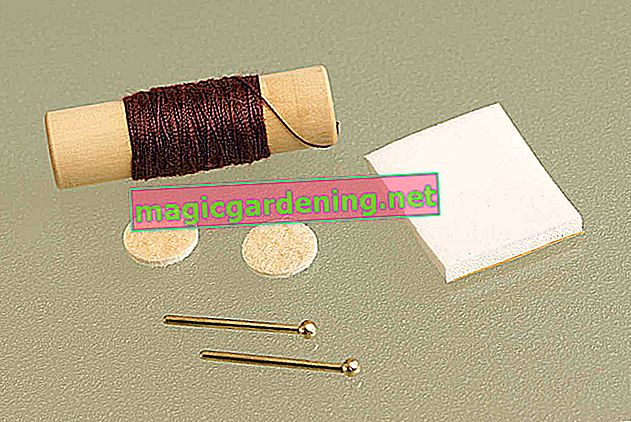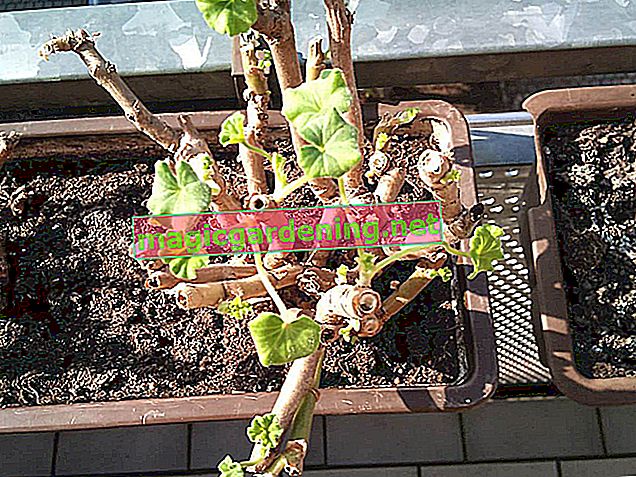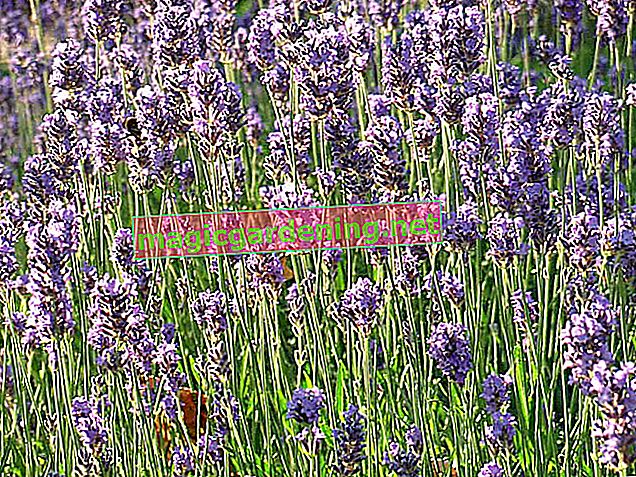
origin
The sword ferns, botanically Nephrolepis, form their own genus within the plant family of the real ferns - and of these they are probably the most popular for ornamental gardening purposes. In addition to its current area of distribution, its astonishing age must also be mentioned in just awe of its origin. Because ferns, like horsetail, are among the first and most enduring structures in the plant world on our planet. Millions of years ago, imposing fern species grew in the primeval forests, long before the flora on earth varied in many ways.
also read
- Is the sword fern poisonous or a harmless houseplant?
- Sword fern care: essential and unnecessary procedures
- Ball robinia: characteristics and care
To this day, ferns have survived in an overall reduced but still very species-rich population, so that one can only take off their hats to their art of survival.
Today's fern species grow in tropical to subtropical areas around the globe. The genus of sword ferns occurs specifically in America - they are at home from southern Florida down to South America.
Sword ferns can only be cultivated here as pure house plants.
Origin at a glance:
- Ferns are among the first plants in the global flora
- Sword ferns are at home in tropical Central and South America
- In this country kept in room culture
growth
Like all ferns, sword ferns grow as perennials. Their characteristic appearance is characterized by the long, arching leaves that are very regular and indestructible with their fine feathering. Depending on the species, they also develop a somewhat more upright habit. The leaves emerge like a rosette from the center of the plant.
In their home areas they usually grow epiphytically as epiphytic plants on large trees. They form a clumpy rhizome root system, which is not critical for its local cultivation - after all, a sword fern has to be kept in a bucket with us anyway, in which it cannot spread out uncontrollably. Nevertheless, this root property naturally requires regular repotting.
Growth characteristics in brief:
- Sword fern grows as a perennial
- Leaves arise like rosettes and form spreading, arching to slightly upright habitus
- Usually growing epiphytically in home areas, i.e. as epiphytes on trees
- Form clumpy rhizome roots
leaves
The leaves of the sword fern are not only the reason for its leaf-sucking status because of their handsome structure - it is a flowerless plant, so you won't get any ornamental value from flowers anyway. To multiply, the sword fern forms round, brownish spore capsules beneath the central leaf ribs.
Like all ferns, the frond-like leaves have a typical pinnate structure and, depending on the variety, are also twisted or wavy in this genus. Overall, the fronds can be up to 1.80 m long. The individual leaflets start alternately and have different shapes from lanceolate to ovoid-rounded, the leaf margins are either finely serrated or smooth. The color is usually a light, fresh green, with some varieties also a darker medium green.
Blade properties in brief:
- Are the only, but very attractive decorative value of the blossomless sword fern
- Reproductive organs in the form of spore capsules are located on the lower central ribs of the leaf
- Feathery structure typical of ferns with different shapes depending on the variety
- Mostly light, fresh green
Which location is suitable?
According to its habitat on large trees in tropical forests, the sword fern needs a bright, but not full sun location. He reacts relatively sensitively to too direct and too frequent solar radiation with brown burn marks. If possible, give it a clear window seat or, if possible, a parking space in the winter garden, where it is surrounded by other plants and is slightly shaded. A thin curtain can also help against intense sun through the window.
The sword fern shouldn't have to endure cool drafts. In terms of temperatures, he needs pleasant, living space-appropriate values between 19 and 22 ° C, but in winter he would like to be a little cooler.
From his tropical home he is used to a high level of humidity, which you should somehow guarantee him at home. A sword fern, for example, thrives in a warm, damp bathroom - of course only if a window lets in enough light.
To note:
- Location bright, but not full sun
- No cold drafts
- High humidity - ideal for bathrooms or a humid conservatory
What soil does the plant need?
Sword ferns need a humus-rich and loose substrate that has a high water storage capacity. It is best to place it in a potting soil mixture loosened up with sand, peat and perlite. A small proportion of peat moss is also welcome to the epiphyte.
Watering sword fern
As a tropical plant, the sword fern loves a lot of moisture. He not only wants to be watered regularly, but also appreciates one or two showers on his leaves with the water disperser. In doing so, you give him homeland conditions. Nevertheless, the plant is sensitive to waterlogging. You should always empty excess water from the saucer as soon as possible.
Use lukewarm, stale water that is as low in lime as possible for watering and especially for spraying.
To note:
- Sword fern needs a lot of moisture, and especially likes water showers on its leaves
- Water regularly, but avoid waterlogging
- Use lukewarm, stale water that is low in calcium
Fertilize sword fern properly
The nutritional requirements of sword ferns are moderate. You don't necessarily need to fertilize it, but you can do it if you value fresh, vital growth. During the growth phase from spring to early autumn, it is by no means wrong to give the sword fern a little fertilizer every one to two weeks. To do this, use a liquid fertilizer for green plants in low dosage. Fertilizer sticks (€ 1.45 at Amazon *) are also suitable. However, if you repot the sword fern every year in a fresh substrate, you can dispense with fertilizing entirely.
Propagate sword fern
As already mentioned, the sword fern is a flowerless plant and has always been based on a spreading mechanism via spores. You can also use this if you want to multiply it yourself and specifically.
Spore sowing
This method is a bit tricky, however, and only works with pure sword fern species. However, it is an interesting challenge for those interested in botany. As soon as the spore capsules have matured brownish on the lower central rib of the leaf, cut off the leaf and place it on a sheet of paper for a few days. At some point the capsules will open and let their dusty contents fall. Put this in planters with potting soil and moisten them well with the water disperser. Cover them with foil or, better yet, use a mini greenhouse. (€ 6.96 at Amazon *) For germination, high humidity, even ventilation and warm temperatures are necessary. When a mossy coating forms on the earth,carefully and under strict hygiene, lift it down and place it in a new substrate. Small sword ferns can grow from it in a bright, sunny spot.
division
Splitting is much easier and less time-consuming. After you have potted the sword fern, you can easily cut the clumpy rhizome roots with a spade or a large knife. Simply put the separated piece in a new bucket with fresh substrate.
Foothills
Older specimens occasionally form small runners from the rhizome roots. You can easily separate these and place them in small growing pots (€ 14.90 at Amazon *) with humus soil. You'd best do it for him in the spring.
Diseases and pests
As with all moisture-loving ornamental plants, a sword fern, especially if kept indoors all year round, can occasionally be infested with spider mites. These parasites find ideal conditions on host plants that are weakened by too much dry heating air. It is therefore always advisable to pay attention to high humidity even with a sword fern and to spray it regularly in addition to watering.
You can easily recognize spider mites by the cobweb-like webs with which they cover the leaves of their host. But the small, greenish to reddish animals can also be seen with the naked eye. The safest, most environmentally friendly and most sensible means is water. It not only removes the cause, namely usually the dryness, but is also extremely unpleasant for the mites. First of all, you can simply rinse them off the leaves with a more powerful jet of water. Then wrap the whole, wet plant under a film that you tie together at the bottom. In this humid environment with little air, the mites usually die within a week.
Is sword fern poisonous?
Sword ferns are considered to be slightly poisonous. Their content of harmful substances is, however, so low that there is no danger to children or pets. Larger amounts would have to be consumed, and in that case the body gets rid of the unwanted substances itself.
Sword ferns are generally considered to be less dangerous than they are to health: they filter pollutants such as xylene or formaldehyde from the air and thus ensure a better indoor climate.
Continue reading
sorts
Of sword ferns, the two species Nephrolepis exaltata and Nephrolepis cordifolia are mainly offered for ornamental purposes in specialist shops. Of these, above all of Nephrolepis exaltata, there are in turn numerous cultivars that differ from one another mainly in the length of the leaves and their pinna.
A very classic variety is the Nephrolepis exaltata 'Green Lady'. It delights with its long leaf fronds in beautiful medium green and with smooth-edged plumage. Their growth is bushy and arching overhanging.
The leaf fronds of the Nephrolepis exaltata 'Corditas' variety, which is also characterized by a very bushy appearance, are a little more finely structured.
If you have a lot of space, for example in a spacious winter garden, you can buy a Nephrolepis exaltata 'Massii': This sword fern inspires with its particularly long and wide fronds in fresh green. This makes it particularly suitable for hanging baskets or for tubs in high racks.








